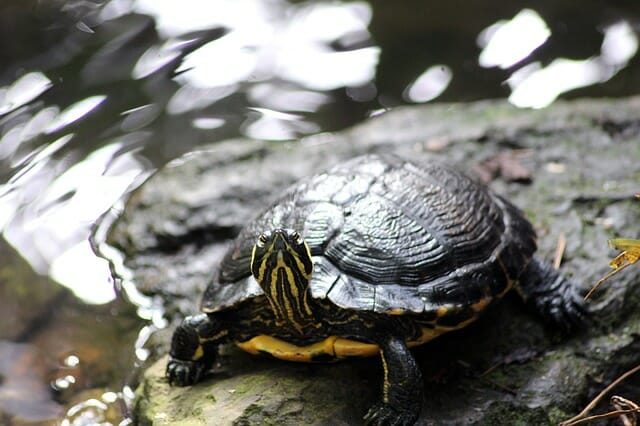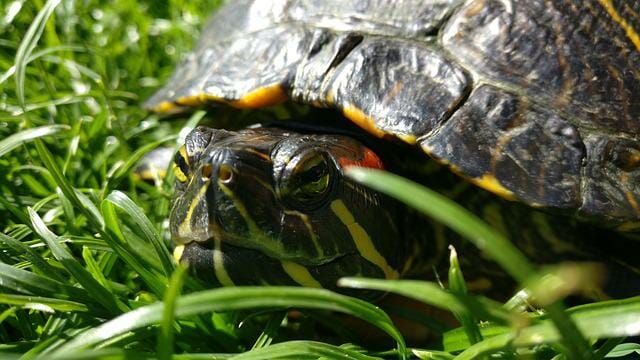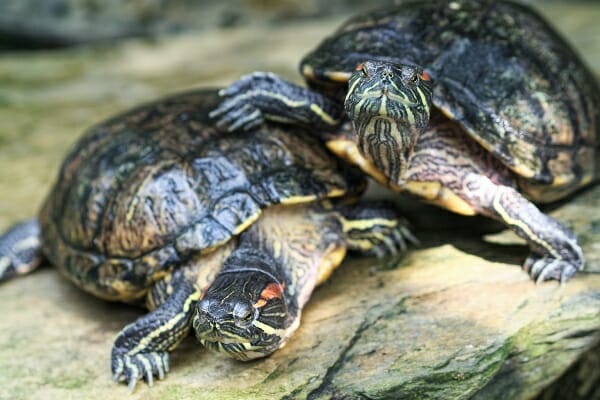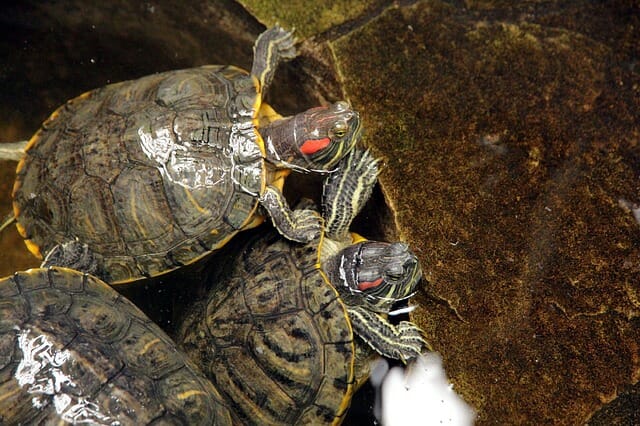How Often Do You Feed Red-Eared Slider Turtles: Tips and Tricks in Feeding Red-Eared Sliders

I had always heard that turtles should eat meat daily, but now I know why. Red-ear slider owners should feed their turtles twice daily, and the amount fed each meal depends on the animal’s age. So when it comes to feeding a red-eared slider, there are three things you want to keep in mind: the size of the food, the frequency of feeding, and the reptile age.
Table of Contents
How to Feed Baby and Juvenile Red-Eared Slider Turtles?
Younger red-eared babies and juvenile turtles should eat protein daily, while older sliders should eat a vegetarian diet predominantly. However, as a red-eared slider grows, its metabolism increases, and it needs more calories. This is why adult red-ears need to eat four times per week, whereas younger ones need to eat twice daily.
As a red-eared slider ages, its appetite becomes even more significant, and it eats like a glutton. If you give one a 4th serving, it might look like it is eating less, but it is getting full faster. So a good rule of thumb is to give a red-eared slider about half its body weight in daily food.
Red-Eared Slider Diet
A red-eared slider’s diet consists of about 25% pellets, 50 % vegetables, and 25% shrimp or mealworm. You could even feed it live foods like crickets or waxworms. They are omnivorous creatures, meaning they eat both meat and plants.
Their diets consist mainly of insects, small fish, crustaceans, worms, snails, frogs, and even some plants like grasses, weeds, and flowers. This makes feeding a red-eared slider easier because you don’t have to worry about switching their diets.

Turtle Food for Red-Eared Slider
Red-eared sliders are a trendy pet. They can be kept in an aquarium or terrarium, and they make great pets because of their size and the fact that they are not aggressive towards humans. The best way to feed them is with live foods such as shrimp, crickets, wax worms, earthworms, etc.
The most important thing when feeding a red-eared slider is to provide them with enough variety to get all the necessary nutrients. In addition, you will want to make sure that they have access to clean water. It is also recommended that you use fresh foods rather than frozen foods. Frozen foods tend to dry out quickly and may cause digestive problems.
When choosing a food for your turtle, you will want to choose a food with high protein content. Protein helps build strong bones and muscles, especially for reptiles. When selecting a food for your turtle, you will want to select a food that contains a balanced amount of carbohydrates, fats, and proteins. Carbohydrates are used by the body to produce energy, fats are used to store energy, and proteins are used to repair cells and tissues.
To ensure that your turtle eats well, you should give it a wide range of foods. If you only give your turtle one type of food, it won’t know what to expect from its meals. By giving your turtle a variety of foods, you will be able to ensure that it receives all the nutrients it needs
Foods to Avoid Feeding to Red-Eared Slider
Red-eared slider food items are some of the most common pets sold today. They are inexpensive, easy to care for, and trendy. However, there are many red-ear slider foods that you should avoid feeding. Here are the ones to look out for:
- Fish Food – This is one of the worst things you could feed your pet. Most commercial brands contain high levels of mercury, which can cause serious health problems for your pet. If you decide to give your pet fish food, ensure it contains no artificial ingredients.
- Corn – Corn is another ingredient you should never feed your pet. It provides little nutrition but can even harm your pet.
- Wheat Middlings – Wheat middles are often used as filler in dog food, low in protein and calories, and offer nothing to your pet.
- Potato Products – Potatoes are another common ingredient in pet food. Some potato products contain hydrogenated oils, which increase cholesterol levels.
- Vegetables – Many vegetables are toxic to dogs. Do not feed your pet carrots, broccoli, cauliflower, green beans, spinach, zucchini, or tomatoes. Be careful about what you put in your pet’s bowl too. Make sure to buy healthy dog food, and keep your pet away from anything that might be harmful to him.
Plant Materials You Can Feed Your Red-Eared Slider
Red-eared sliders are omnivorous eaters and will happily munch on just about anything you give them. They can live relatively long lives, sometimes exceeding 20 years, and are known for being extremely friendly and easy to care for.
A well-balanced diet comprises around 60% vegetables and 40% meat. Protein-based plant foods include peas, carrots, broccoli, spinach, cabbage, corn, and potatoes. Calcium vegetables include alfalfa sprouts, celery, cucumbers, eggplant, okra, squash, sweet potato, tomatoes, zucchini, and yellow squash.
The best way to ensure a healthy diet is to provide various foods, including those listed above. To ensure your pet gets enough calcium, add a few slices of cheese to their diet now and again.

Vitamins and Minerals for Red-Eared Slider Turtles
The American Veterinary Medical Association recommends feeding a healthy adult red-ear slider a diet consisting of 50% to 60% vegetable matter, 20% to 30% grain, 10% to 15% meat and fish, and less than 10% fat. A commercial food explicitly formulated for red-ear sliders is recommended for young birds, while older pets may prefer a home-cooked diet.
A veterinarian suggests giving your pet a vitamin supplement once per week, along with a second dose of calcium, such as calcium blocks or cuttlebones, twice per week. Calcium supplements should always be given separately from other nutrients since they can cause diarrhea if consumed together.
Turtle Eating Habits
Turtles are opportunists. They don’t mind eating anything that is in front of them. So, for example, if you see a worm crawling across the ground, your turtle could easily pick up and consume that worm without even thinking about it. This is one of the main reasons why turtles often seem to be hungry.
If you notice your turtle seems to be constantly hungry, try to determine whether they are eating correctly. Turtles require certain nutrients like vitamin B12, calcium, and iron. These vitamins help keep your turtle healthy. To ensure proper nutrition, ensure your turtle gets plenty of greens, fruits, vegetables, and meats.
You can also offer turtle treats such as freeze-dried shrimp, cheese, liver paste, and peanut butter. Treats are great because they allow your turtle to enjoy something tasty while providing them with essential vitamins and minerals.

Water Intake of Turtles
Aquatic turtles swim in the water and drink water all day; therefore, keeping a well-functioning filter system clean is key to keeping the water healthy. Turtles do best with clean, clear water maintained within a specific range of temperatures.
Turtles are susceptible to changes in water quality, so you must maintain good water quality in your tank. If you have any other questions about the nutrition or care of turtles, make sure you seek the advice of a veterinarian knowledgeable about turtles.
Remember, turtles and other reptiles often carry salmonella bacteria on their skins or in their digestive systems, so always wash your hands thoroughly after handling or caring for turtles.